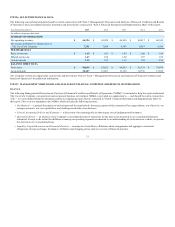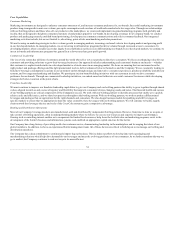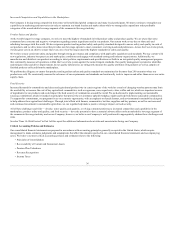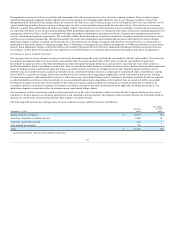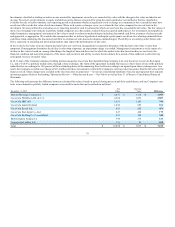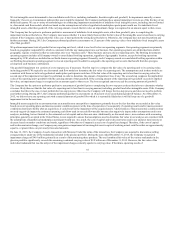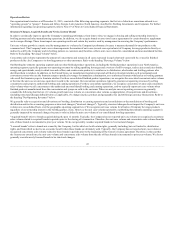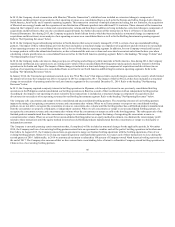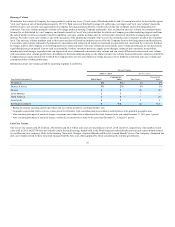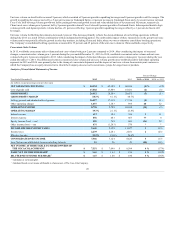Coca Cola 2015 Annual Report Download - page 42
Download and view the complete annual report
Please find page 42 of the 2015 Coca Cola annual report below. You can navigate through the pages in the report by either clicking on the pages listed below, or by using the keyword search tool below to find specific information within the annual report.
Other Assets
Our Company invests in infrastructure programs with our bottlers that are directed at strengthening our bottling system and increasing unit case volume.
Additionally, our Company advances payments to certain customers for distribution rights as well as to fund future marketing activities intended to generate
profitable volume and expenses such payments over the periods benefited. Payments under these programs are generally capitalized and reported in the line
items prepaid expenses and other assets or other assets, as appropriate, in our consolidated balance sheets. When facts and circumstances indicate that the
carrying value of these assets (or asset groups) may not be recoverable, management assesses the recoverability of the carrying value by preparing estimates
of sales volume and the resulting gross profit and cash flows. These estimated future cash flows are consistent with those we use in our internal planning. If
the sum of the expected future cash flows (undiscounted and without interest charges) is less than the carrying amount, we recognize an impairment loss. The
impairment loss recognized is the amount by which the carrying amount exceeds the fair value.
Property, Plant and Equipment
As of December 31, 2015, the carrying value of our property, plant and equipment, net of depreciation, was $12,571 million, or 14 percent of our total assets.
Certain events or changes in circumstances may indicate that the recoverability of the carrying amount or remaining useful life of property, plant and
equipment should be assessed, including, among others, the manner or length of time in which the Company intends to use the asset, a significant decrease in
market value, a significant change in the business climate in a particular market, or a current period operating or cash flow loss combined with historical
losses or projected future losses. When such events or changes in circumstances are present and an impairment review is performed, we estimate the future
cash flows expected to result from the use of the asset (or asset group) and its eventual disposition. These estimated future cash flows are consistent with those
we use in our internal planning. If the sum of the expected future cash flows (undiscounted and without interest charges) is less than the carrying amount, we
recognize an impairment loss. The impairment loss recognized is the amount by which the carrying amount exceeds the fair value. We use a variety of
methodologies to determine the fair value of property, plant and equipment, including appraisals and discounted cash flow models, which are consistent with
the assumptions we believe hypothetical marketplace participants would use.
Goodwill, Trademarks and Other Intangible Assets
Intangible assets are classified into one of three categories: (1) intangible assets with definite lives subject to amortization, (2) intangible assets with
indefinite lives not subject to amortization and (3) goodwill. For intangible assets with definite lives, tests for impairment must be performed if conditions
exist that indicate the carrying value may not be recoverable. For intangible assets with indefinite lives and goodwill, tests for impairment must be performed
at least annually or more frequently if events or circumstances indicate that assets might be impaired.
The following table presents the carrying values of intangible assets included in our consolidated balance sheet (in millions):
December 31, 2015
Carrying
Value
Percentage
of Total
Assets1
Goodwill $ 11,289
13%
Bottlers' franchise rights with indefinite lives 6,000
7
Trademarks with indefinite lives 5,989
7
Definite-lived intangible assets, net 690
1
Other intangible assets not subject to amortization 164
*
Total $ 24,132
27%
* Accounts for less than 1 percent of the Company's total assets.
1 The total percentage does not add due to rounding.
When facts and circumstances indicate that the carrying value of definite-lived intangible assets may not be recoverable, management assesses the
recoverability of the carrying value by preparing estimates of sales volume and the resulting gross profit and cash flows. These estimated future cash flows are
consistent with those we use in our internal planning. If the sum of the expected future cash flows (undiscounted and without interest charges) is less than the
carrying amount of the asset (or asset group), we recognize an impairment loss. The impairment loss recognized is the amount by which the carrying amount
exceeds the fair value. We use a variety of methodologies to determine the fair value of these assets, including discounted cash flow models, which are
consistent with the assumptions we believe hypothetical marketplace participants would use.
40



